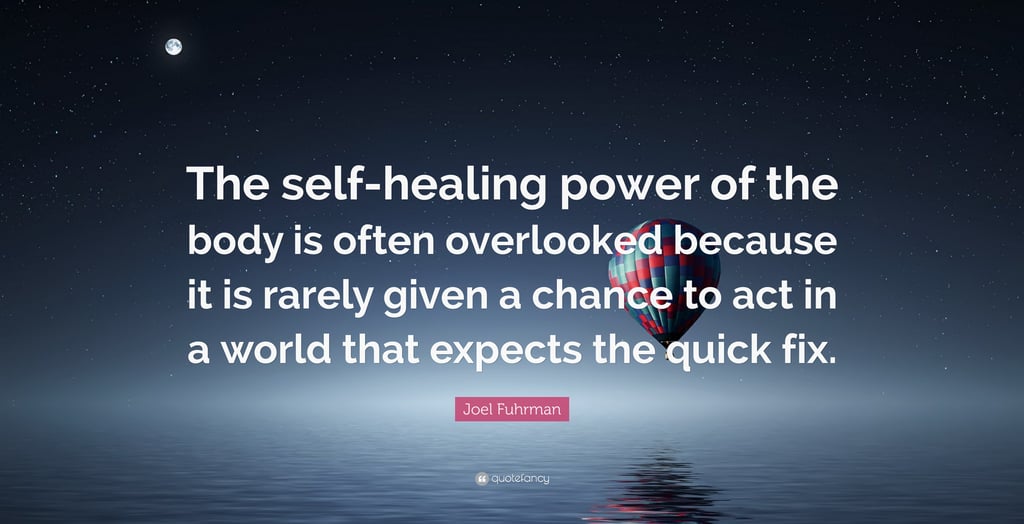

The Incredible Healing Power of Your Body
Our bodies are incredible self-repair machines. From the daily upkeep of our gut to the liver's impressive healing abilities and the brain's adaptability, a lot is happening behind the scenes to keep us running smoothly. Let’s explore how these processes work and why listening to your body’s signals is essential for recovery.
How Our Organs Heal Themselves
When injured, our organs employ two main strategies to heal.
First, damaged cells replicate their DNA but don’t fully divide, allowing them to maintain their functions while compensating for lost cells. This helps organs like the heart continue their vital work even during recovery.
Second, organs contain stem-like cells that can rapidly divide to repair lost tissue. However, this fast repair comes with a risk—too many rapidly dividing cells can increase cancer risk, while having too many oversized cells with extra DNA might lead to chronic dysfunction. By using both strategies, organs strike a balance to support their health and functionality.
The Gut: Your Daily Rebuilder
Your gut acts like a high-speed construction site, continuously replacing its inner lining. Studies show that in mice, mature cells can transform into stem cells to replenish those crucial repair workers. This means that even when the gut is worn out, it can quickly repair itself—much like having a dedicated team of emergency builders on standby! (Source)
The Liver: The Regeneration Champ
The liver is the heavyweight champion of self-healing. It can even regenerate to its full size if damaged—imagine it cutting in half and growing back! Recent research reveals that specific liver cells take on the job of repairing damaged tissues. To maintain this impressive ability, it’s crucial to avoid excessive alcohol and support the liver with a balanced diet. (Source)
The Brain: The Clever Adaptor
Although brain cells can’t replace themselves like skin cells, the brain uses neuroplasticity to reroute functions around damaged areas. Think of this as finding new shortcuts when the usual routes are blocked. Rehabilitation and therapies can enhance this process, helping the brain adapt and recover as effectively as possible. (Source)
Other Organs: Unique Renewal Methods
Blood Vessels and Nerves: The Healing Team
Blood vessels and nerves work together like a well-coordinated repair team. When peripheral nerves (like those in your arms or legs) are injured, blood vessels step in to guide the healing process. New blood vessels grow into the damaged area, creating a structured framework that acts like a scaffold. This scaffold helps reshape the injury site and provides the perfect environment for nerves to regrow.
This process, called angiogenesis, is how new blood vessels form from existing ones. But it’s not just about delivering oxygen and nutrients—it’s also about directing the repair. Blood vessels help build protective tubes around regrowing nerves, shielding them from harmful substances in the bloodstream. At the same time, the endothelial lining of these blood vessels plays a key role in maintaining healthy blood flow and supporting the repair process. Researchers have found that genes like Atf3 activate endothelial cells to regenerate and repair damage, ensuring the blood vessels themselves stay functional during healing. (Source) (Source)
Heart: The Repair Specialists
Our hearts have a remarkable ability to repair themselves after a heart attack. Recent research highlights the crucial role of the immune system and the lymphatic system in this repair process. Macrophages, specialized immune cells, are key players. They clear out dead tissue and produce a protein called VEGFC, which helps form new blood vessels and promotes healing. Scientists are exploring ways to enhance the number of beneficial macrophages or increase VEGFC production to improve heart recovery. (Source)
But that’s not all—the heart also relies on collateral circulation, a network of backup blood vessels that can step in when main arteries are blocked. These smaller vessels act like detours, rerouting blood flow to ensure the heart muscle still gets the oxygen and nutrients it needs. Over time, the body can grow new collateral vessels through angiogenesis, the same process that helps repair peripheral nerves. Regular aerobic exercise, like running or cycling, can even encourage the growth of these backup vessels, making the heart more resilient to damage.
By combining the power of immune cells, new blood vessel formation, and collateral circulation, the heart demonstrates its incredible ability to heal and adapt. Researchers are now working on ways to boost these natural processes, offering hope for better recovery after heart attacks and other cardiovascular conditions. (Source)
Kidneys: The Housekeeping Heroes
The kidneys have a surprising self-renewal method that doesn’t involve dividing cells. Researchers from the University of Texas at Dallas discovered that kidney cells use a "housekeeping" process. Instead of splitting into new cells, they expel old or damaged parts through tiny bubbles called vesicles. These vesicles help cells clear out unnecessary materials and refresh themselves. This process helps keep kidneys healthy and might lead to new treatments for kidney disease. (Source)
Pancreas: The Regenerative Powerhouse
The pancreas is another organ with impressive regenerative abilities. When it gets injured, it can recover by transforming and multiplying its cells. While human beta cells in the pancreas don’t regenerate very much, scientists are working on ways to boost this process and improve treatments for conditions like diabetes. (Source)
Stomach Lining: The Quick Renewers
The stomach lining has a quick renewal process too. New cells are made every 3-4 days to keep the stomach’s lining fresh. This speedy turnover is crucial for protecting the stomach from damage due to acids and infections. If this renewal process is disrupted, it can lead to problems like gastritis or ulcers, showing just how important it is to keep your stomach lining healthy. (Source)
Bladder: The Constant Refreshers
The urinary bladder also has an impressive renewal system. It constantly renews its lining to protect against damage from urine. The cells in the bladder lining are replaced regularly to maintain its function and health. (Source)
Prostate: The Resilient Repairer
Similarly, the prostate has its own renewal processes. Recent studies show that the prostate can regenerate its tissue and repair itself. This is essential for maintaining prostate health and function, especially as men age. By studying mouse prostates and human samples, researchers found that after surviving androgen deprivation—a common therapy for advanced prostate cancer—some cells turn into regeneration superheroes, acquiring the power to rebuild prostate tissue. This discovery highlights the prostate's impressive ability to bounce back after a tough treatment! (Source)
Lungs: The Regenerative Network
Lungs are constantly working to repair and regenerate themselves. Researchers are studying how lung epithelial cells, which line the respiratory tract, handle damage from pollutants and diseases like COVID-19. They are particularly interested in how mesenchymal cells, which support lung tissue, interact with epithelial cells to aid in regeneration. This research aims to improve treatments for respiratory conditions and enhance our understanding of lung repair mechanisms. (Source)
Skin: A Built-In Repair Superhero
Our skin is like a superhero when it comes to healing! After an injury, it springs into action with impressive speed and precision, swiftly covering the damage with new tissue and restoring itself to its former glory. Recent research from Oslo University Hospital and the University of Oslo reveals that skin cells, when exposed to blood-like conditions, move in a highly organized fashion driven by tiny pulling forces known as “supracellular tensile forces.” This amazing ability shows that our skin has pre-installed mechanisms for self-repair. (Source)
It’s important to note that while the body can heal itself—to a certain extent—certain injuries or diseases may still require medical intervention for a full recovery.
Supporting Your Body’s Natural Signals
To make the most of your body’s incredible repair systems, it’s essential to listen to its signals and take proactive steps. Supporting cellular repair and overall well-being involves more than just eating well—it also means addressing key systems like the gut-brain-liver axis. Implementing strategies such as the 2 simple ways to reset the gut-brain-liver axis can significantly enhance your body’s natural healing processes.
By tuning in to your body’s needs and following these proven methods for resetting and restoring balance, you can bolster your internal repair mechanisms and promote optimal health. Your body is always communicating with you; responding thoughtfully to these signals is crucial for maintaining balance and well-being.
Return to:
